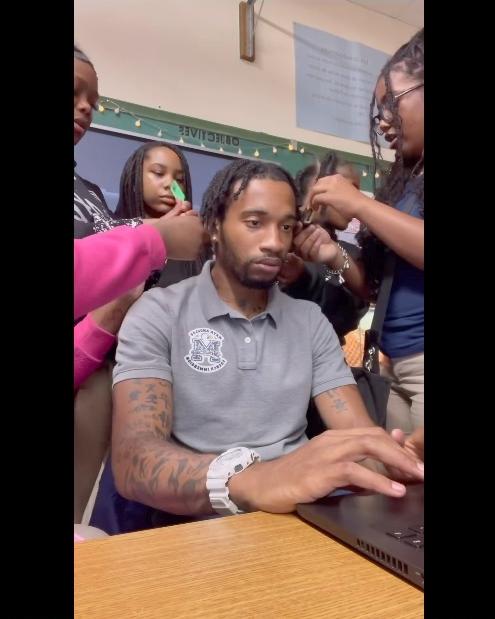Introduction: The trend of students unbraiding teachers hair
Imagine walking into a classroom where students unbraiding teachers hair usual chatter is replaced by giggles and whispers. Students cluster around their teacher, not with questions about math or science, but with curiosity about her hair. Yes, you read that right—students unbraiding teachers’ hair has become a fascinating trend sweeping across schools. This playful act transcends mere aesthetics; it’s an expression of trust, creativity, and connection between students and educators. But what drives this unique phenomenon? Let’s dive deeper into the world of students unbraiding teachers’ hair and explore its implications in today’s educational environment.
Why do students unbraid their teacher’s hair?
Students unbraiding their teacher hair often stems from a mix of curiosity and playfulness. It’s an unexpected interaction that flips the traditional student-teacher dynamic on its head, creating a more relaxed atmosphere.
Many students see it as a way to express creativity. Hair can be seen as an art form, and what better canvas than someone they admire? This act can spark conversations about style, culture, and personal expression in a way textbooks cannot.
Additionally, this playful act fosters bonding moments. It breaks down barriers and may help teachers appear more approachable. The classroom becomes less formal when laughter replaces rigidity.
For some students, it’s also about trust. Unbraiding hair demonstrates a level of comfort with their teacher—a sign that they feel safe in that environment. It creates shared experiences that deepen relationships beyond academia.
The benefits of unbraiding hair in the classroom
Unbraiding hair in the classroom can foster a sense of community. It creates an environment where creativity thrives. Students and teachers bond over this playful activity, breaking down traditional barriers.
This simple act also promotes relaxation. A moment spent unbraiding allows both students and teachers to unwind from academic pressures. It offers a unique way to destress during busy school days.
Additionally, it encourages collaboration. Working together on something as personal as hair fosters teamwork skills that can translate into group projects or discussions.
Moreover, unbraiding hair provides opportunities for cultural exchange. Different braiding styles can spark conversations about heritage and traditions, enhancing understanding among diverse backgrounds.
Engaging in such activities cultivates empathy and kindness within the classroom setting. It’s not just about hair; it’s about connection and shared experiences that matter deeply in education.
Potential concerns and controversies surrounding this trend
While the trend of students unbraiding teachers’ hair may seem lighthearted, it does raise some important concerns. One major issue is personal boundaries. Not every teacher may be comfortable with this practice, and it’s essential to respect their wishes.
Another concern involves cultural appropriation. Hair braiding holds significance in various cultures. If not approached thoughtfully, students might unintentionally offend or misrepresent those traditions.
Additionally, there’s the potential for distractions in the classroom environment. Unbraiding hair could shift focus away from lessons and disrupt learning.
Students must also consider consent and context. A playful gesture among peers can quickly turn inappropriate if boundaries are crossed or misunderstandings arise.
Awareness of these issues ensures that everyone involved feels respected and valued within the school community.
Tips for students on how to respectfully and safely students unbraiding teachers hair
Before approaching your teacher about braiding their hair, always ask for permission. Respect is key in any interaction. A simple “Would you mind if I braid your hair?” can set the right tone.
Choose a time when they seem relaxed and open to some fun. Avoid interrupting them during serious moments or busy tasks.
When you start, be gentle with their hair. Use soft hands and avoid tugging at knots or tangles. It’s important to make the experience enjoyable for both of you.
Consider involving them in the process students unbraiding teachers hair ! Ask which style they’d prefer—there are countless options from classic braids to creative designs.
Keep it light-hearted and remember this is all about building rapport. If at any point they seem uncomfortable, stop immediately and switch gears. Communication goes a long way in ensuring everyone has a positive experience.
Perspectives from teachers and students who have participated in this practice
Teachers and students who have embraced the trend of unbraiding hair often share intriguing insights. For many students, it’s a way to foster connection. One student remarked that unbraiding their teacher’s hair made them feel closer, turning an ordinary classroom experience into something memorable.
On the other hand, teachers frequently view this practice of students unbraiding teachers hair as a form of trust and camaraderie. A teacher commented on how it opens up a dialogue about personal expression in the classroom. It breaks down barriers and enhances mutual respect.
However, reactions can vary based on individual comfort levels. Some educators appreciate the gesture but prefer to keep professional boundaries intact. Others fully enjoy engaging with their students in this unique manner, finding joy in playful interactions that enhance learning environments.
These diverse perspectives highlight the multifaceted nature of this trending phenomenon within educational settings.
Conclusion: The impact of unbraiding teachers’ hair on classroom dynamics and relationships
The practice of students unbraiding teachers hair has sparked a unique dynamic in classrooms. It fosters an environment of trust and camaraderie between educators and their pupils. When a student takes the time to engage with a teacher in such an intimate way, it can break down barriers that often exist in traditional educational settings.
This act can serve as a form of expression, allowing students to bond over creativity and cultural practices. Teachers who embrace this trend often find themselves more connected to their students, leading to improved classroom morale. The playful nature of unbraiding hair can lighten the atmosphere, turning an ordinary day into something memorable.
However students unbraiding teachers hair, it’s crucial for both parties to maintain respect for personal boundaries during these interactions. Clear communication is key; consent should always be prioritized. If both sides feel comfortable, this activity can enhance mutual understanding and respect.
The impact of students unbraiding teachers hair extends beyond just hair—it’s about building relationships that encourage collaborative learning environments where everyone feels valued and included. This emerging trend highlights how small acts within the classroom can lead to significant changes in dynamics and connections between students and teachers alike.



